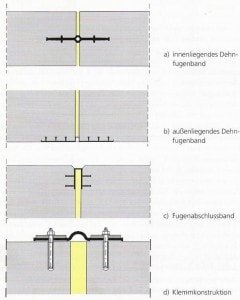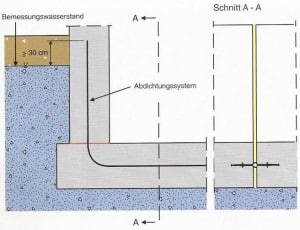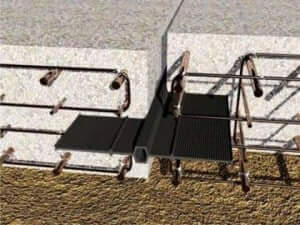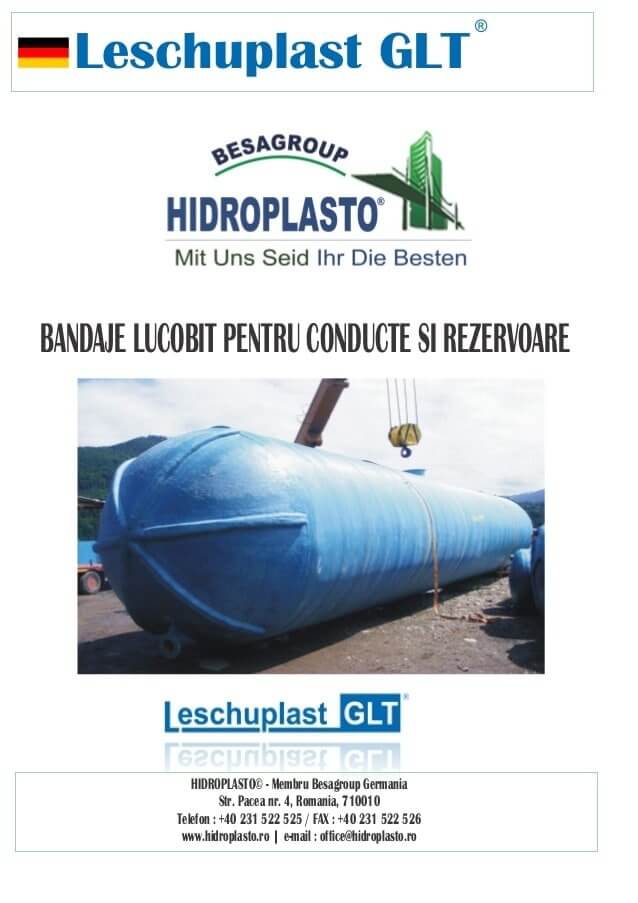Synthetic material spacers are, beside concrete spacers, the most popular group of reinforcement bar spacers. Such spacers are made of an impact-resistant material, they are also completely water-repellent. The structure of the spacers allows their full coverage with concrete, which increases the fire resistance level of the entire structure. In many European countries (i. e. Germany), fire resistance of spacers is neglected and treated as corresponding to the concrete class in a structure. Synthetic material spacers can be divided into a few groups:
- for horizontal reinforcement bars – among them are linear or point spacers, they are characterised by great resistance to loads,
- for vertical reinforcement bars – spacers, the structure of which allows them to be attached to vertical reinforcement bars by means of diverse clamps or fasteners,
- for horizontal and vertical reinforcement bars – spacers having a small footprint, i. e. types DV, DST, are used in precasting plants.
TRICK linear plastic spacer
| TRICK linear plastic spacer pad | |||||
| Symbol | Concrete cover [mm] | Package bunch/pallet [mb] | Sales unit | Weight [kg/100 mb] | Art. no. |
| TRICK 15 | 15 | 100/5400 | bunch | 13,0 | PA-PD-TS-0-01331 |
| TRICK 20 | 20 | 100/6000 | bunch | 15,0 | PA-PD-TS-0-01332 |
| TRICK 25 | 25 | 100/5600 | bunch | 16,0 | PA-PD-TS-0-01333 |
| TRICK 30 | 30 | 100/3600 | bunch | 17,0 | PA-PD-TS-0-01334 |
| TRICK 35 | 35 | 60/2880 | bunch | 22,0 | PA-PD-TS-0-01335 |
| TRICK 40 | 40 | 60/2400 | bunch | 28,4 | PA-PD-TS-0-01336 |
| TRICK 50 | 50 | 60/1800 | bunch | 37,0 | PA-PD-TS-0-01337 |
A modern, stable and universal use spacer made of synthetic material, with a length of 2000 mm. Allows achieving cover thickness values between 15 mm and 50 mm, side recesses reduce thermal expansion and allow the reinforcement bars and the spacer itself to be fully covered.
ISO-TRICK linear plastic spacer
| ISO-TRICK linear plastic spacer | |||||
| Symbol | Concrete cover [mm] | Package bunch/pallet [mb] | Sales unit | Weight [kg/100 mb] | Art. no. |
| ISO-TRICK 15 | 15 | 100/5400 | bunch | 14,0 | PA-PD-TS-0-01290 |
| ISO-TRICK 20 | 20 | 100/4800 | bunch | 17,0 | PA-PD-TS-0-01291 |
| ISO-TRICK 25 | 25 | 100/4200 | bunch | 18,0 | PA-PD-TS-0-01292 |
| ISO-TRICK 30 | 30 | 50/3600 | bunch | 21,0 | PA-PD-TS-0-01293 |
| ISO-TRICK 35 | 35 | 50/2880 | bunch | 29,0 | PA-PD-TS-0-01294 |
| ISO-TRICK 40 | 40 | 50/2400 | bunch | 34,9 | PA-PD-TS-0-01295 |
| ISO-TRICK 50 | 50 | 50/1440 | bunch | 49,5 | PA-PD-TS-0-01296 |
Its advantage is the option of arranging it on a soft surface, i. e. styrofoam, mineral wool, bentonite or a binding layer. Spacer length: 2000 mm.
SUPER TRICK linear plastic spacer
| SUPER-TRICK linear plastic spacer | |||||
| Symbol | Concrete cover [mm] | Package bunch/pallet [mb] | Sales unit | Weight [kg/100 mb] | Art. no. |
| SUPER TRICK 15 | 15 | 100/5000 | bunch | 5,4 | PA-PD-TS-0-01321 |
| SUPER TRICK 20 | 20 | 100/5000 | bunch | 8,4 | PA-PD-TS-0-01323 |
| SUPER TRICK 25 | 25 | 100/5000 | bunch | 9,3 | PA-PD-TS-0-01324 |
| SUPER TRICK 30 | 30 | 100/5000 | bunch | 11,5 | PA-PD-TS-0-01325 |
| SUPER TRICK 35 | 35 | 80/3200 | bunch | 15,0 | PA-PD-TS-0-01326 |
| SUPER TRICK 40 | 40 | 80/3200 | bunch | 16,7 | PA-PD-TS-0-01327 |
| SUPER TRICK 45 | 45 | 80/3200 | bunch | 19,2 | PA-PD-TS-0-01328 |
| SUPER TRICK 50 | 50 | 80/3840 | bunch | 21,7 | PA-PD-TS-0-01329 |
| SUPER TRICK 60 | 60 | 82/3280 | bunch | 26,7 | PA-PD-TS-0-01330 |
Stable linear spacing component for lower reinforcement layer, with a length of 2000 mm. Numerous openings allow proper coverage by concrete both of the rebar as well as the spacer. Thanks to this, such flaws as linear cracks where the reinforcement concrete component deflects.
DST linear plastic spacer
| Podkładka plastikowa liniowa DST | |||||
| Symbol | Concrete cover [mm] | Package bunch/pallet [mb] | Sales unit | Weight [kg/100 mb] | Art. no. |
| DST 15 | 15 | 100/5000 | bunch | 8,6 | PR-PD-00-0-01724 |
| DST 20 | 20 | 100/5000 | bunch | 9,0 | PR-PD-00-0-01725 |
| DST 25 | 25 | 100/4000 | bunch | 9,2 | PR-PD-00-0-01726 |
| DST 30 | 30 | 100/3000 | bunch | 9,6 | PR-PD-00-0-01727 |
| DST 35 | 35 | 100/1000 | bunch | 10,0 | PR-PD-00-0-01728 |
| DST 40 | 40 | 100/1000 | bunch | 10,6 | PR-PD-00-0-01729 |
| DST 45 | 45 | 100/1000 | bunch | 10,8 | PR-PD-00-0-01730 |
| DST 50 | 50 | 100/1000 | bunch | 11,2 | PR-PD-00-0-01732 |
Synthetic material linear spacer for the lower horizontal reinforcement bar layer, utilised mainly in pre-casting plants. It is characterised by a small footprint, thanks to which it has limited visibility in the concrete on the non-processed surface. Specially shaped endings allow joining of the spacers in order to increase their joint length. Usable length per segment is 485 mm.
DVS linear plastic spacer with clamp
| DVS linear plastic spacer with clamp | |||||
| Symbol | Concrete cover [mm] | Package bag/pallet [pcs.] | Sales unit | Weight [kg/100 pcs.] | Art. no. |
| DVS 15 | 15 | 380/12160 | bag | 2,35 | PR-PD-00-0-01717 |
| DVS 20 | 20 | 350/11200 | bag | 2,45 | PR-PD-00-0-01718 |
| DVS 25 | 25 | 320/10240 | bag | 2,55 | PR-PD-00-0-01719 |
| DVS 30 | 30 | 280/8960 | bag | 2,65 | PR-PD-00-0-01720 |
| DVS 35 | 35 | 260/8320 | bag | 2,75 | PR-PD-00-0-01721 |
| DVS 40 | 40 | 200/6400 | bag | 2,85 | PR-PD-00-0-01722 |
| DVS 45 | 45 | 200/6400 | bag | 2,95 | PR-PD-00-0-01723 |
Synthetic material spacer for lower layers of horizontal or vertical reinforcement bars, utilised mainly in pre-casting plants. It has limited visibility on non-processed surfaces. It has clamps helping to maintain the rebar at its designated spot. Spacing between clamps is 150 mm, total length 283 mm, width 48 mm.
DV linear plastic spacer
| DV linear plastic spacer | |||||
| Symbol | Concrete cover [mm] | Package bag/pallet [pcs.] | Sales unit | Weight [kg/100 pcs.] | Art. no. |
| DV 15 | 15 | 400/11200 | bag | 2,400 | PR-PD-00-0-01709 |
| DV 20 | 20 | 350/9800 | bag | 2,600 | PR-PD-00-0-01710 |
| DV 25 | 25 | 300/8400 | bag | 2,900 | PR-PD-00-0-01711 |
| DV 30 | 30 | 250/7000 | bag | 3,200 | PR-PD-00-0-01712 |
| DV 35 | 35 | 230/6440 | bag | 3,500 | PR-PD-00-0-01713 |
| DV 40 | 40 | 200/5600 | bag | 3,800 | PR-PD-00-0-01714 |
| DV 45 | 45 | 200/5600 | bag | 4,400 | PR-PD-00-0-01715 |
| DV 50 | 50 | 200/5600 | bag | 5,000 | PR-PD-00-0-01716 |
Synthetic material linear spacer for the lower horizontal reinforcement bar layer, utilised mainly in pre-casting plants. It is characterised by a small footprint, it has limited visibility in structural concrete on non-processed surfaces. Specially shaped endings allow joining of the spacers in order to increase their joint length. Usable length per segment is 95 mm, lenght 215 mm.
RAS linear plastic spacer
| RAS linear plastic spacer | |||||
| Symbol | Concrete cover [mm] | Package bag/pallet [pcs.] | Sales unit | Weight [kg/100 pcs.] | Art. no. |
| RAS 15 | 15 | 300/12000 | bag | 0,196 | PR-PD-00-0-05770 |
| RAS 20 | 20 | 300/12000 | bag | 0,199 | PR-PD-00-0-01055 |
| RAS 25 | 25 | 300/12000 | bag | 0,202 | PR-PD-00-0-05771 |
| RAS 30 | 30 | 300/12000 | bag | 0,205 | PR-PD-00-0-05772 |
| RAS 35 | 35 | 300/9000 | bag | 0,208 | PR-PD-00-0-05773 |
Spacer for horizontal rebar, mainly used at precasting plants. It is characterised by a small footprint, which causes it to be invisible in unprocessed external concrete components. Circle diameters between 180 mm and 315 mm.
PADIX point plastic spacer
| PADIX point plastic spacer | ||||||
| Symbol | Rebar diameter Φ [mm] | Concrete cover [mm] | Package bag [pcs.] | Sales unit | Weight [kg/100 pcs.] | Art. no. |
| PADIX 15/4-12 | 4-12 | 15 | 1000 | bag | 0,24 | PA-PD-TS-0-01250 |
| PADIX 20/4-12 | 4-12 | 20 | 1000 | bag | 0,43 | PA-PD-TS-0-01251 |
| PADIX 20/6-20 | 6-20 | 20 | 250 | bag | 0,75 | PA-PD-TS-0-01256 |
| PADIX 25/4-12 | 4-12 | 25 | 1000 | bag | 0,62 | PA-PD-TS-0-01257 |
| PADIX 25/6-20 | 6-20 | 25 | 250 | bag | 0,85 | PA-PD-TS-0-01262 |
| PADIX 30/6-20 | 6-20 | 30 | 125 | bag | 1,40 | PA-PD-TS-0-01268 |
| PADIX 35/4-12 | 4-12 | 35 | 200 | bag | 1,04 | PA-PD-TS-0-01271 |
| PADIX 35/6-20 | 6-20 | 35 | 125 | bag | 1,808 | PA-PD-TS-0-01274 |
| PADIX 40/6-20 | 6-20 | 40 | 125 | bag | 1,870 | PA-PD-TS-0-01282 |
| PADIX 40/4-12 | 4-12 | 40 | 125 | bag | 1,670 | PA-PD-TS-0-01279 |
| PADIX 50/4-12 | 4-12 | 50 | 100 | bag | 2,280 | PA-PD-TS-0-01283 |
| PADIX 50/6-20 | 6-20 | 50 | 50 | bag | 2,360 | PA-PD-TS-0-01286 |
PADIX – injection spacer characterised by enhanced resistance. Recommended for use for vertical rebar.
STYROFIX point plastic spacer
| STYROFIX point plastic spacer | ||||||
| Symbol | Rebar diameter Φ [mm] | Concrete cover [mm] | Package bag [pcs.] | Sales unit | Weight [kg/100 pcs.] | Art. no. |
| STYROFIX 15 | 8-16 | 15/20 | 500 | bag | 1,10 | PA-PD-TS-0-01315 |
| STYROFIX 25 | 8-16 | 25/30 | 400 | bag | 1,30 | PA-PD-TS-0-01316 |
| STYROFIX 40 | 6-16 | 40/50 | 200 | bag | 2,20 | PA-PD-TS-0-01317 |
| STYROFIX 50 | 6-16 | 50/60 | 200 | bag | 2,50 | PA-PD-TS-0-01318 |
| STYROFIX 70 | 8-16 | 70/80 | 200 | bag | 3,50 | PA-PD-TS-0-01319 |
| STYROFIX 90 | 8-16 | 90/100 | 100 | bag | 4,70 | PA-PD-TS-0-01320 |
Spacer foreseen for reinforcement bars laid out on a soft layer, i. e. styrofoam, mineral wool, bentonite matt or directly on the soil. Depending on the layout of the rebar on the spacer, two cover thickness values may be attained.
FIX point plastic spacer
| FIX point plastic spacer | ||||||
| Symbol | Rebar diameter Φ [mm] | Concrete cover [mm] | Package bag [pcs.] | Sales unit | Weight [kg/1000 pcs.] | Art. no. |
| FIX 15 | 4-16 | 15 | 1000 | bag | 4,00 | PA-PD-TS-0-01297 |
| FIX 20 | 4-16 | 20 | 500 | bag | 5,00 | PA-PD-TS-0-01299 |
| FIX 25 | 4-16 | 25 | 500 | bag | 5,70 | PA-PD-TS-0-01300 |
| FIX 30 | 4-16 | 30 | 250 | bag | 6,60 | PA-PD-TS-0-01302 |
| FIX 35 | 4-16 | 35 | 250 | bag | 7,30 | PA-PD-TS-0-01303 |
| FIX 40 | 4-16 | 40 | 250 | bag | 8,20 | PA-PD-TS-0-01304 |
| FIX 45 | 4-16 | 45 | 125 | bag | 9,20 | PA-PD-TS-0-01305 |
| FIX 50 | 4-16 | 50 | 125 | bag | 10,40 | PA-PD-TS-0-01306 |
Spacer with a special clamp. Maintains stability and binds well with concrete.
BARYŁKA point plastic spacer
| BARYŁKA point plastic spacer | ||||||
| Symbol | Rebar diameter Φ [mm] | Concrete cover [mm] | Package bag [pcs.] | Sales unit | Weight [kg/100 pcs.] | Art. no. |
| BARYŁKA 15 | 6-14 | 15 | 500 | bag | 4,20 | PA-PD-TS-0-01310 |
| BARYŁKA 20 | 6-14 | 20 | 500 | bag | 4,30 | PA-PD-TS-0-01311 |
| BARYŁKA 25 | 6-14 | 25 | 500 | bag | 4,40 | PA-PD-TS-0-01313 |
| BARYŁKA 30 | 6-14 | 30 | 500 | bag | 4,90 | PA-PD-TS-0-01314 |
Spacer used for horizontal reinforcement systems. Equipped with clamps protecting the spacer against shifting.
KOŚĆ point plastic spacer
| KOŚĆ point plastic spacer | ||||||
| Symbol | Rebar diameter Φ [mm] | Concrete cover [mm] | Package bag [pcs.] | Sales unit | Weight [kg/500 pcs.] | Art. no. |
| KOŚĆ 15/20/25 | 6-14 | 15/20/25 | 500 | bag | 2,72 | PA-PD-TS-0-01309 |
| KOŚĆ 20/25/30/35 | 6-14 | 20/25/30/35 | 500 | bag | 6,76 | PA-PD-TS-0-01312 |
| KOŚĆ 20/25/30 | 6-14 | 20/25/30/ | 500 | bag | 4,08 | PA-PD-TS-0-16970 |
Spacer for horizontal reinforcement bars. Allows for five different concrete cover thickness values of 15 mm, 20 mm, 25 mm, 30 mm and 35 mm depending on the spacer type, its mode of layout on the surface and the specific layout of reinforcement bars.
Formwork accesories



